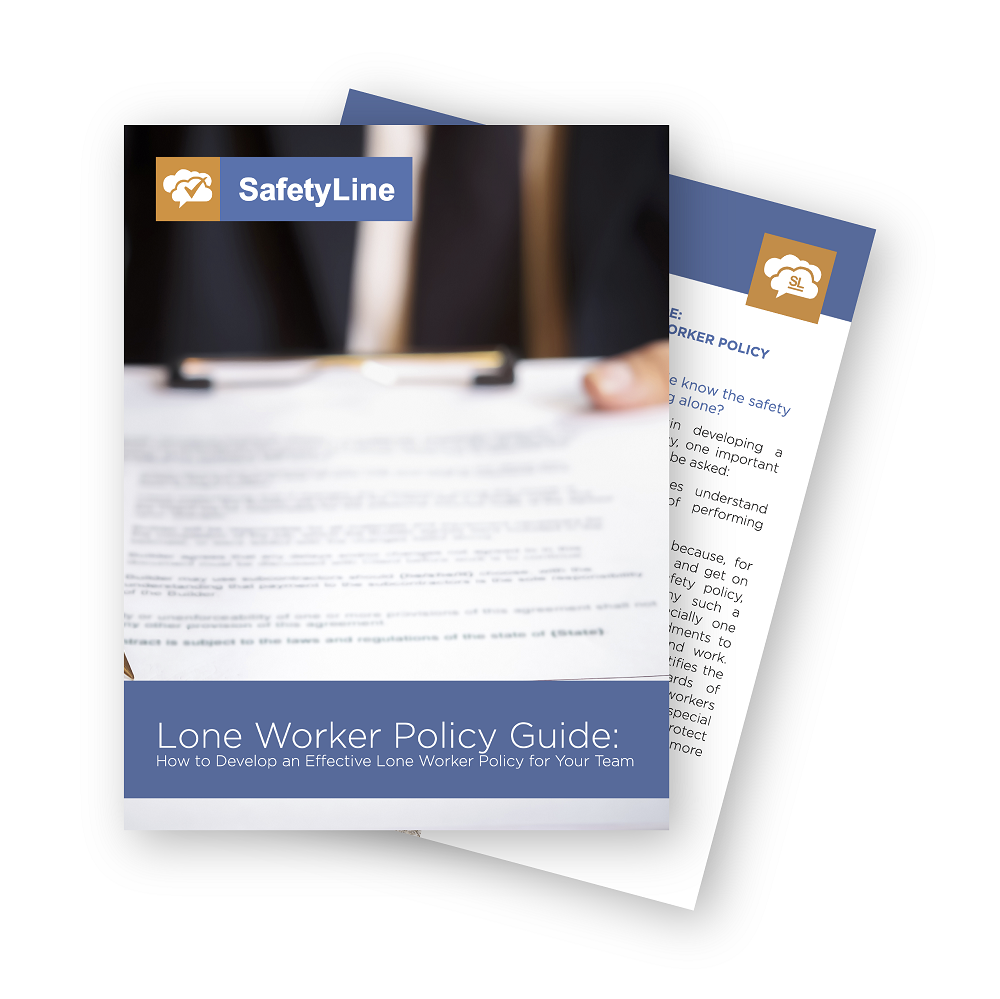Featured Resources
Lone Worker Policy Guide and Template
A lone worker policy is an effective way to ensure that your lone workers are well-educated on your company’s work-alone rules and have extensive knowledge of all workplace hazards that could be encountered on the job.
Hazard Assessment Guide
In the process of doing a hazard assessment for your workplace, it is almost a certainty you’ll learn information about the operational aspects of your organization you were unaware of before the assessment.
View eBook
Develop a Free Lone Worker Program for Small Teams
Developing a free lone worker check-in system is a simple process for small teams that any organization can implement.
View eBook
SafetyLine Blog Categories
General Safety | Lone Worker Safety | SafetyLine News and Updates | SafetyLine Product Updates | Compliance, Policy, and Regulations | Downloadable Resources |
4 Ways SafetyLine Complies with Manitoba Lone Worker Regulations and Legislation
Manitoba is one of the seven provinces in Canada that regulate working alone. Given that having at least two employees on a job site was not always practical or useful in protecting workers, these regulations were established to ensure the safety of those workers who were required to perform their jobs alone.
Discover the Benefits of Location Tracking for Lone Workers with Garmin Satellite Devices
Did you know that there are about 3,000 satellites orbiting above our heads, transmitting billions of signals, relaying important information? Some of that valuable data include the locations of workers who are out on the job and without a cellular connection. Satellite technology can save the lives of those working remotely, empowering employers to send help to the right location when seconds can make the difference between life or death in a work emergency.
Work From Home Hazard Assessment Guide
When COVID-19 turned our world upside down last spring, the global labor market responded, sending many of its workers to perform their jobs remotely and at home. According to Stats Canada, nearly 40% of Canadians were working from home in the last week of March and those numbers have undoubtedly increased over the summer. And according to the Stanford Institute for Economic Policy Research, as of June, 42% of the
What are the Key Strengths a Lone Worker Needs to be Successful?
While most of us can adapt to working by themselves and/or remotely, it takes a particular kind of person with special expertise to thrive in these new conditions. For example, an anxious person could find lone work difficult as there are less structure and more responsibility and unpredictability. If some of your team members are struggling with this new professional world, hopefully, this article will provide you with some insight to help them out, increasing productivity and well-being as a result.
What SafetyLine Users Are Saying: Lone Workers in Healthcare and Government
The types of organizations and industries that use SafetyLine to protect their remote workers range from healthcare and legal services to agriculture and government at all levels - and yes, those working at home can be considered lone workers. In the first of a three-part series, here are what our grateful SafetyLine users are saying about the service as well as how it has improved the safety and wellness of their remote teams, helping protect their most valuable resource – their people.
Essential Work-from-home Areas to Focus on During 2nd Wave of COVID-19
As we approach what could be another wave of COVID-19 and therefore more workers doing their jobs remotely or at home, employers must not only make their safety a priority, but must also focus on the three areas of mental health, engagement and productivity. After many months of living in a pandemic world, you workers may experience quarantine fatigue with their anxiety increasing, and their engagement and productivity decreasing.
Lonely but Not Powerless: Embrace These Unique Times
In the early days of working from home, it was great. But after the quick honeymoon period (about a month into the quarantine), there were times I desperately wished I had the privacy of my old office. I found that there were more disruptions at home, like our son crawling into my workspace while on a call or having to meet the Amazon delivery guy downstairs, that were breaking my train of thought – I know, first-world problems. One day, I texted a single friend to see how he was doing during the quarantine and working from home. He told me it was getting tough and he was lonely. I never thought of that way and it put my circumstances into serious perspective. I began asking questions like, “How are people finding that meaningful connection during quarantine?”
On a Tight Budget? Here’s how to Protect Your Lone Workers Without Breaking the Bank
This is the second article of a three-part series: Setting Up a Lone Worker Safety Program, we look at how a company can implement a lone worker safety program on a budget. These days, budgets are stretched thin and are uncertain, making it difficult to allocate funds for areas such as lone worker safety. But lone worker safety should be a priority when you look at the potential legal, reputational and financial costs if one of your lone workers, unfortunately, experiences an accident that could have been prevented or mitigated by the organization.
What Does a Lone Worker Look Like?
In the picture above, can you spot out the lone worker? No? That’s because the lone worker comes from every background and demographic, looking like you and I. This is the first article of a three-part series: Setting Up a Lone Worker Safety Program. The profile of a lone worker has…
Safety and Key Elements to Successful Working Relationships with Remote Teams
Managing an entirely remote workforce is a phenomenon that many Canadian businesses would have never imagined being tasked with. However, the past few months have forced companies across Canada to adjust to new work-from-home environments. One of the most important drivers of workplace productivity is the network of working relationships within an organization. This article will breakdown the key components of fostering successful relationships with remote working teams.
Should you leave your remote workers alone?
With all of the things going on in the world right now, the safety of workers, remote workers, in particular, is a big concern. For any employer, it is a big job to keep their remote team safe and productive during these unique times, on top of the challenges of maintaining productivity operations. When it comes to remote workers, managers can spend a lot of time making sure these staff members are safe and are getting their work done. The good news is that…
Developing a Free Lone Worker Program
If an emergency occurs, lone workers rarely have the resources or back-up necessary to safely deal with the situation alone. Situations that involve confrontation, personal injury, or violence, can quickly become serious if immediate help is not available. Many organizations employ staff who are considered to be lone workers. Any adverse situation can become life-threatening if not immediately detected and resolved. This is why every organization should have a check-in system in place to ensure the safety of their people throughout the day, regardless of their location or activity.
Regular Check-ins and Location Tracking During COVID-19: Are Your Workers Safe Right Now?
The COVID-19 virus has impacted millions of lives around world, changing how we shop, affecting how we socialize and perhaps most significantly, transforming how we work. Because of the pandemic, most of us are now working from home and in other remote offices, trying our best to adapt to this very different world…
Remote and Lone Worker Safety During the “New Normal” (COVID-19)
The spread of COVID-19 has forced most Canadian businesses to implement mandatory work-from-home policies. As much of Canada’s workforce navigates the transition of working in an office to working from home, the ability to work remotely is more important more than ever. For many industry sectors, the phenomenon of employees working from home is a novel, and possibly intimidating reality. However, this new reality is here to stay for the foreseeable future. Thus, remote workers and lone workers' safety are more important than ever right now.
The Importance of Safety Check-ins for Water Utility Companies
What could have prevented these accidents? What could have the workers’ managers done beforehand to possibly prevent these horrible events from happening? While different safety steps could have been taken for each situation, an automated check-in system with fall detection for all of the workers mentioned may have saved their lives or at least lessened the severity of their injuries.
Are Work From Home Jobs Considered Lone Workers?
To slow the spread of COVID-19, restaurants, bars, and public spaces have closed throughout Canada. Following suit, offices have also shut their doors and implemented mandatory work-from-home policies to support self-isolation and social distancing mandates. For many employers and employees, this is a novel concept that requires significant adjustment. Although the transition for some industries may be seamless, other organizations will face significant challenges along the way. As Canada’s workforce shifts from office to working from home, all companies are faced with a new challenge –how to protect their staff who may now be working remotely or alone.
How To Protect Your Employees Working From Home Alone During The Coronavirus Pandemic
With the COVID-19 virus spreading across the entire globe, more of your team members are going to have to work at home and in many cases, alone. But because you’re not sharing an office with these workers, it doesn’t mean that you can’t protect your team. Here are 5 tips…
The Importance of Self-Care When Social Distancing and Working From Home
When working from home, the line between your personal and professional life can become increasingly blurred, which can make it difficult to “turn off” and relax. To maintain your emotional and physical well-being while practicing social distancing, here are some tips to keep your two worlds balanced while working from home.
Hazards and the Growing Need for Safety in Community Healthcare
As an increasing number of health authorities move towards providing more and more care in the comfort of the patient’s home, so does the incidence of assaults and abuse towards these health care workers who are venturing into the community alone to provide the needed care.
Lone Worker Risks in the Canadian Forestry Sector
When it comes to our Canadian economy, the forestry industry provides a substantial source of wealth for the country. Our forestry trade balance (the difference between what we import and what we export to international partners) accounts for $19.8 billion of Canada’s GDP, according to the Government of Canada. This is equivalent to about 2% and represents the most substantial forest product trade balance in the world. We have held this position for years, and the gap between Canada and Sweden (the second-largest net trader) has been steadily increasing since 2009.





















